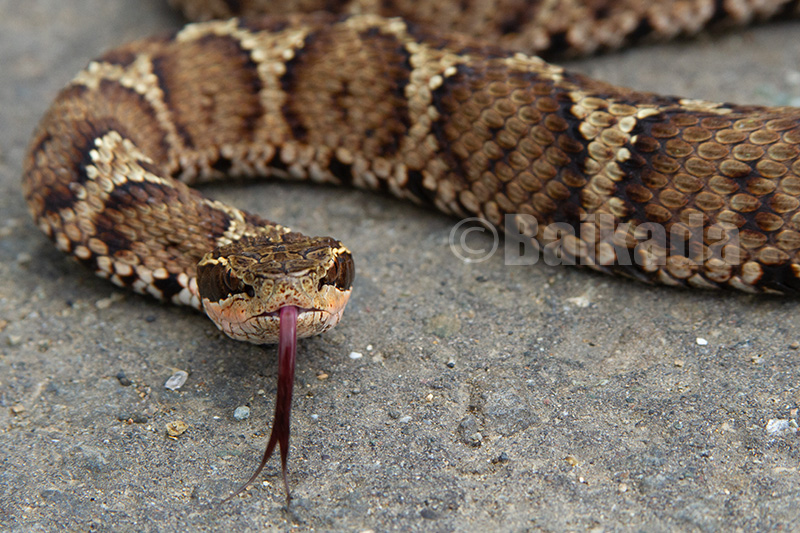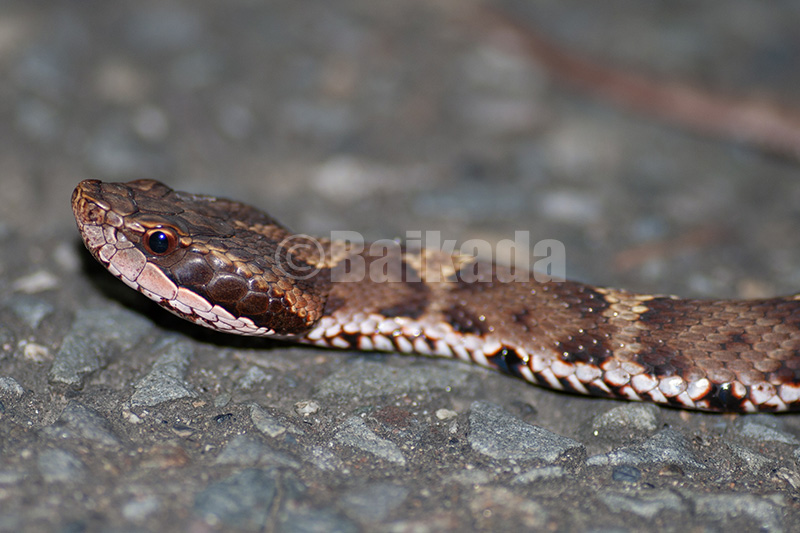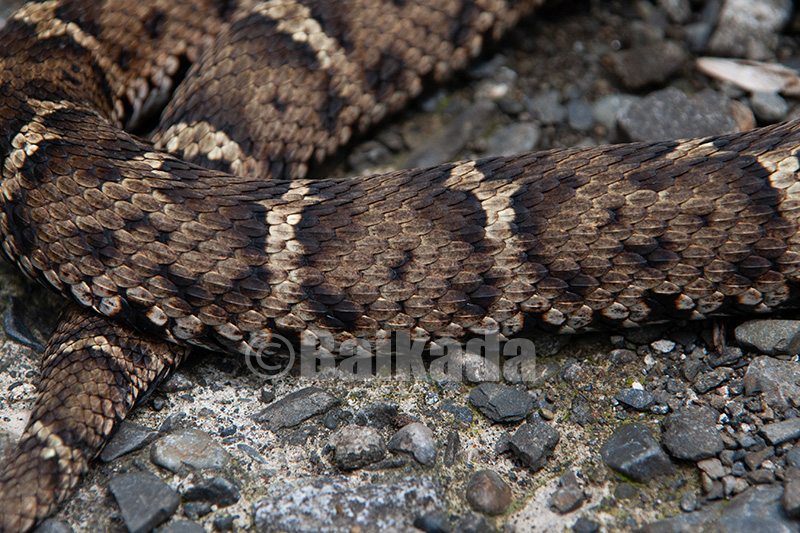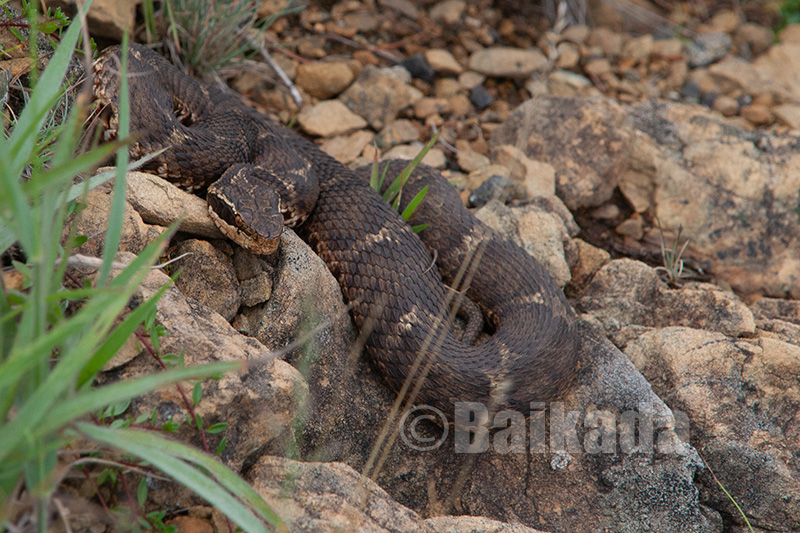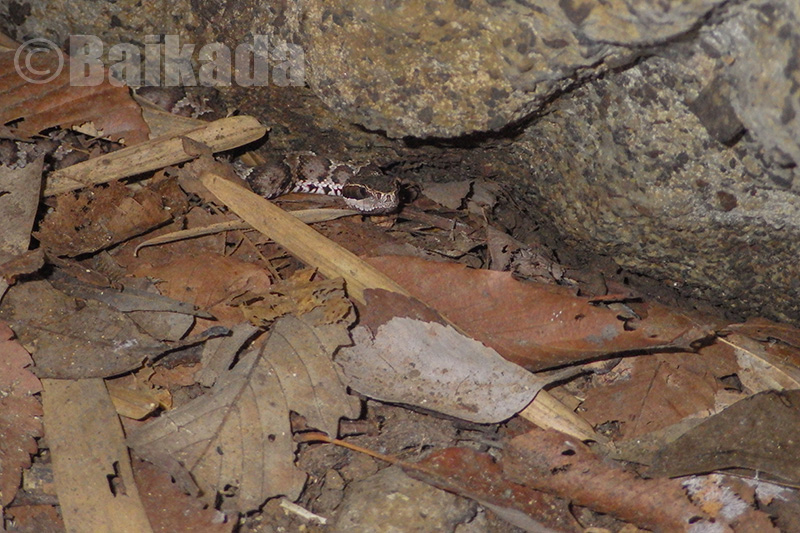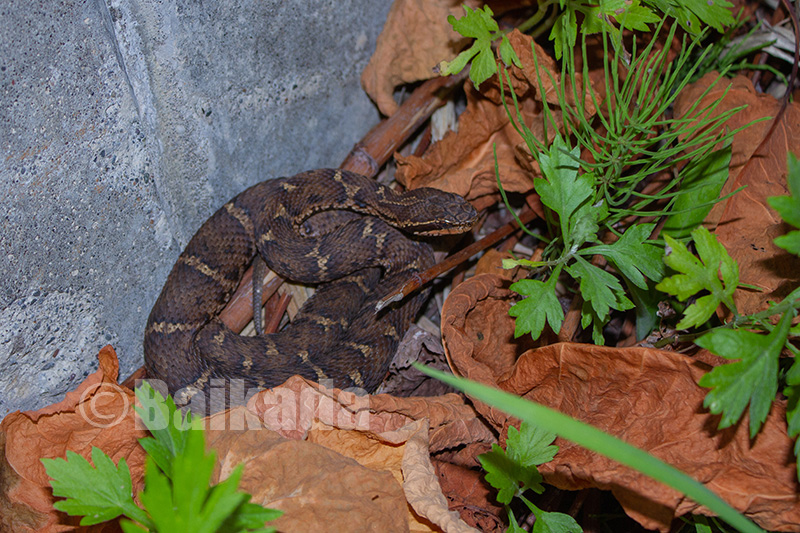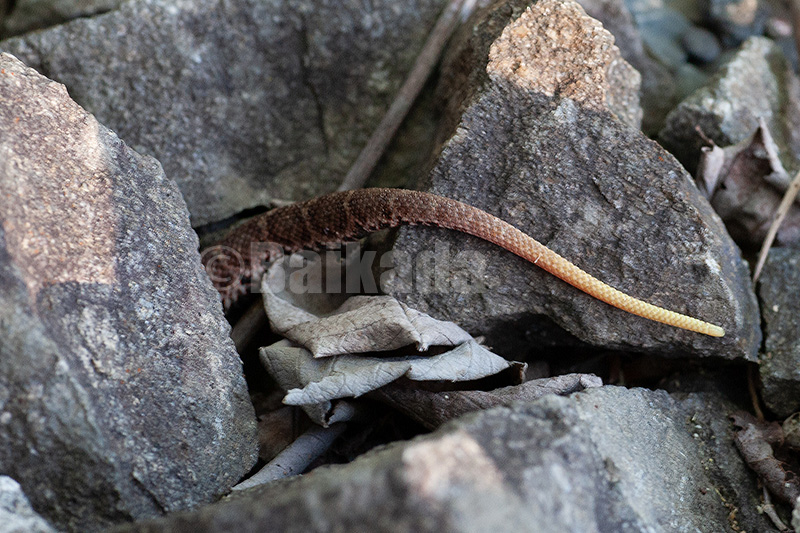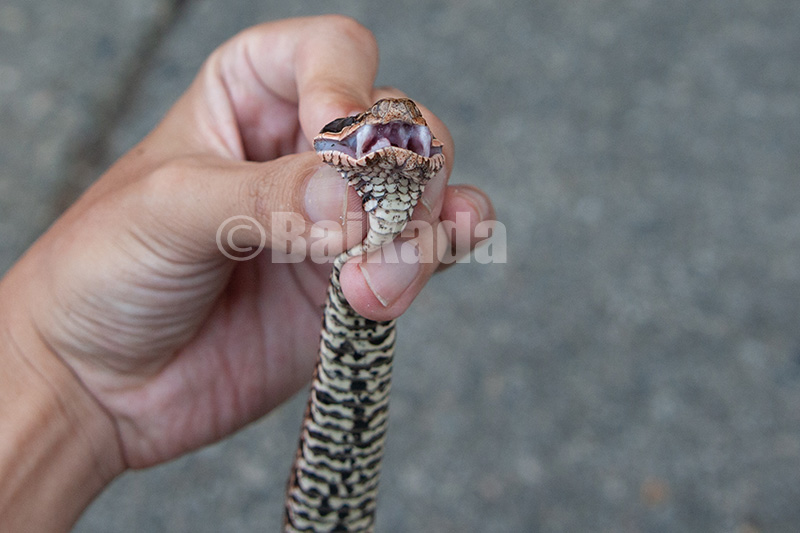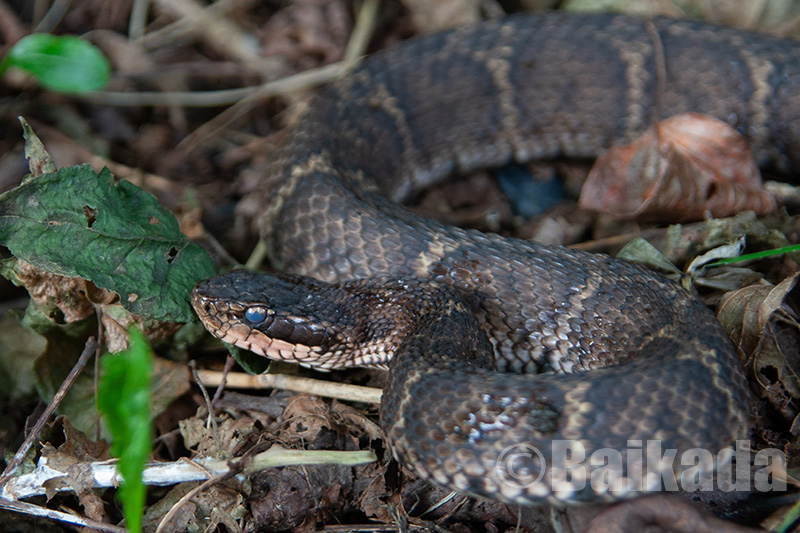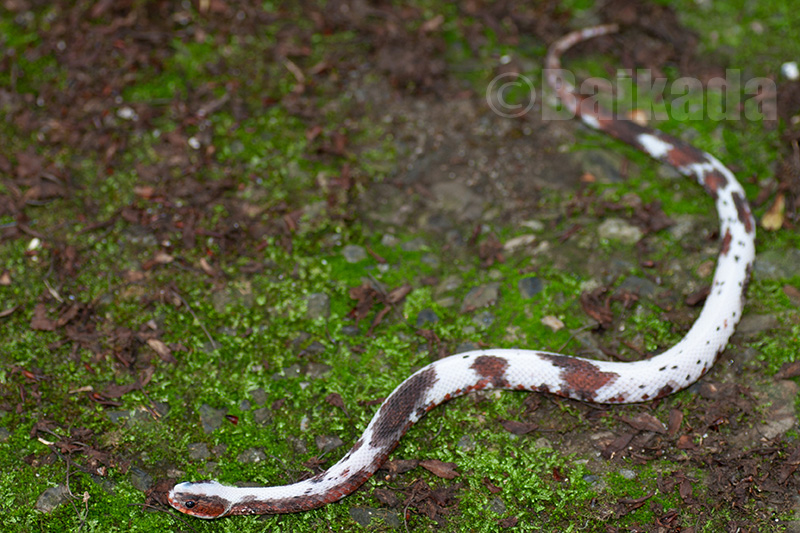*The highlighted portions of the text are subjective opinions based on the author’s experience. Please be careful if you refer to this.
*ハイライト部分は著者の経験による主観なので、引用する場合は注意して下さい。
和名:ニホンマムシ(日本蝮)
英名:Mamushi
学名:Gloydius blomhoffii
From Hokkaido. Photo:Baikada
北海道札幌市産. 撮影:ばいかだ
From Hokkaido. Photo:Baikada
北海道遠軽町産. 撮影:ばいかだ
北海道・本州・四国・九州・国後島・天売島・佐渡島・隠岐・壱岐・五島列島・甑島列島・屋久島・種子島・伊豆大島。
Hokkaido, Honshu, Shikoku, Kyushu, Kunashiri Island, Teuri Island, Sado Island, Oki Island, Iki Island, Goto Islands, Koshiki-Jima Islands, Yaku-shima Island, Tanega-shima Island, Izu-Oshima island.
全長40~65cm。北海道や天売島では80cmに達する個体も見られる。褐色から赤褐色の地色のものが多く、左右の体側に20対前後の楕円形の暗色斑がある。暗斑紋の中心付近の色は薄く、真ん中には暗色の点があり、「5円玉」のような銭型紋に見える事が多い。暗色斑の縁取りや中心点は個体によって濃淡の差が大きい。胴が太く、尾が短いなどずんぐりした体型に見える。目の瞳孔は縦長だが、夜は丸くなる。腹面は市松模様(チェッカー)状の模様になっている。舌の色は黒~暗赤色で根元が赤っぽい。眼線が太く、境界が明瞭。
Total length 40 – 65 cm, with some individuals reaching 80 cm in Hokkaido and Teuri Island. The ground color is usually brown to reddish brown, and there are about 20 pairs of oval dark spots on each side of the body. The dark spots are lighter in color near the center and have a dark spot in the middle, which often looks like a coin-shaped pattern like a 5 yen coin. The edges and center of the dark spots vary greatly in shade depending on the individual. They appear to be stocky, with a thick body and short tail. The pupils of the eyes are long and narrow, but become round at night. The ventral surface has a checkerboard pattern. The tongue is black to dark red with a reddish base. Eye line is thick and the boundary of the eye line is clear.
From Teuri island. Photo: Baikada
北海道天売島産, 撮影:ばいかだ
Top view.
上面。銭形紋は体の左右にあるのがわかる
From Shiga. Photo: Baikada
滋賀県産, 撮影:ばいかだ
The tongue color is black to dark red.
暗赤色の舌.
From Hokkaido. Photo: Baikada
北海道札幌市産, 撮影:ばいかだ
The tongue is black to dark red with a reddish base.
舌の根元は赤っぽい
From Miyazaki. Photo: Baikada
宮崎県産, 撮影:ばいかだ
Eye line is thick and the boundary of the eye line is clear.
眼線が太く、境界が明瞭
From Hokkaido. Photo: Baikada
北海道札幌市産, 撮影:ばいかだ
The dark spots are lighter in color near the center and have a dark spot in the middle, which often looks like a coin-shaped pattern like a 5 yen coin.
銭形紋は中央にある5円玉状だが、個体変異で変異がある。【・】 が多いけど、たまに 【・ᴗ・】 とかあるのが可愛い。
From Hokkaido. Photo: Baikada
北海道札幌市産, 撮影:ばいかだ
Flattened head.
頭部は扁平で斑紋が見られるが、この斑紋は一様ではなく個体差が大きい
From Hokkaido. Photo: Baikada
北海道札幌市産, 撮影:ばいかだ
The ventral surface has a checkerboard pattern.
腹板は黒~朱色の細かい斑があり、市松模様をなす
From Miyazaki. Photo: Baikada
宮崎県産, 撮影:ばいかだ
The pit in front of the eye is the “pit organ “of the temperature-sensing organ.
目の前にある窪みは温度感知器官の「ピット器官」
From Hokkaido. Photo: Baikada
北海道札幌市産, 撮影:ばいかだ
As a nocturnal species, the pupil is narrow during the day.
夜行性種であるため瞳孔は昼は縦に細くなっている。
From Hokkaido. Photo: Baikada
北海道札幌市産, 撮影:ばいかだ
The pupils are round and large at night.
瞳孔は夜は丸く大きくなっている。
胴の中央部付近で21列。鱗には強いキールがあり、触るとザラザラした手触り。
Body scales are 21 rows near the middle of the body. The scales have a strong keel and are rough to the touch.
From Hokkaido. Photo: Baikada
北海道札幌市産, 撮影:ばいかだ
The scale has strong keel.
鱗には強いキール(盛り上がり)が見られる
捕食など活発に行動するのは夜間だが、昼間にも日光浴している姿も見られる。特にメスが産仔前(秋)に出ているのが見られるケースは多い。
ほとんど地面におり、追い詰めたり混乱しない限り木などに登ることはほとんどない。
比較的穏やかな性格の持ち主が多いが、多くの個体は「触る・踏む・蹴る・棒でつつく」などすると反撃として咬みついてくる神経質さは持っている。決して刺激しないこと。
They are most active at night when they are feeding, but they can also be seen basking in the sun during the day. They can also be seen sunbathing during the day, especially when females are pregnant (in autumn).
They stay on the ground most of the time and do not climb trees unless cornered or confused.
Most of them are relatively gentle, but many of them are nervous and will bite back if you touch, step on, kick, or poke them with a stick. Never provoke them.
From Hokkaido. Photo: Baikada
北海道札幌市産, 撮影:ばいかだ
Pregnant female basking in the sun.
日光浴中の妊娠雌
From Hokkaido. Photo: Baikada
北海道札幌市産, 撮影:ばいかだ
Pregnant female.
妊娠雌
From Teuri island. Photo: Baikada
北海道天売島産, 撮影:ばいかだ
They sometimes wander to prey on frogs on rainy nights.
雨の夜にカエルを求めて徘徊することがある
比較的深い森~里山に生息している。またその周辺の田畑にも出没する。日が当たる山中の岩場や、河川敷、海岸付近の岩場で日光浴する個体が見られることもある。
They are found in relatively deep forests and suburban mountains. They can also be found in the surrounding fields. Some individuals can be seen sunbathing on rocky areas in the mountains, riverbeds, or near the coast.
From Hokkaido. Photo: Baikada
北海道様似町産, 撮影:ばいかだ
Sunbathing on a rocky beach in the mountains.
山中の岩場で日光浴。
From Hokkaido. Photo: Baikada
北海道, 撮影:ばいかだ
An example of habitat.
環境の一例:山地の岩場
From Gunma. Photo: Baikada
群馬県産, 撮影:ばいかだ
When they are in a fallen leaf environment, it is difficult to recognize where they are.
落ち葉環境にいると、どこにいるかわかりにくい。
From Hokkaido. Photo: Baikada
北海道石狩市産, 撮影:ばいかだ
At near artificial concrete blocks on the shoreline.
海岸線の人工的なコンクリートブロック付近で
From Shimane. Photo: Baikada
島根県産, 撮影:ばいかだ
Individuals found in wetlands around lakes.
湖沼周辺の湿地で見られた個体
From Teuri Island in Hokkaido. Photo: Baikada
北海道天売島産, 撮影:ばいかだ
Since it is not a large species, it may not be able to get out if it falls into a gutter.
大きい種でないため、側溝に落ちると出られないこともある。
カエルやネズミを中心に様々な小型脊椎動物を食べる。ムカデの死骸も食べることがわかってきた。
It eats a variety of small vertebrates, mainly frogs and mice. It has been found that they also eat centipede carcasses.
尾の色が薄かったり黄色かったりする。これをルアーにして餌を寄せると思われる行動をとる事がある。その他はほとんど成体と同じ外見。生まれた時は全長約20cm。
The color of the tail is pale yellow. They sometimes use this as a lure to attract food. Other than that, it looks almost the same as the adult. When born, they are about 20 cm long.
From Hokkaido. Photo: Baikada
北海道札幌市産, 撮影:ばいかだ
Juvenile.
幼蛇
From Hokkaido. Photo: Baikada
北海道札幌市産, 撮影:ばいかだ
It is a poisonous snake, so be careful when handling it.
小さいが毒があるので取り扱い注意。
From Hokkaido. Photo: Baikada
北海道札幌市産, 撮影:ばいかだ
Juveniles have yellow tips on their tails.
幼蛇は尾の先が黄色い。
From Hokkaido. Photo: Baikada
北海道札幌市産, 撮影:ばいかだ
Adults do not have yellow tips on their tails.
成蛇の尾の先は黄色くなく、茶色か黒ずむことが多い。
強い毒をもつ。毒の作用は、筋肉部に毒が入ると筋を腫脹・融解・壊死させたり、赤血球や筋破壊による血色素尿や筋色素尿症を呈し、腎不全に至ることもある。また、神経系の作用が出ることもまれにあり、物が二重に見えるなどの症状が起こることもある。(大陸産のマムシの仲間では神経系の作用がより強い)
中型の蛇なのであまり毒量は多くないが、年間咬傷件数が多く、決して侮れない強さの毒のため、治療が遅れたことで死亡する例もある。
怪しい蛇にかまれた場合は病院にすぐ行くこと。またジャパンスネークセンターに相談して的確な指示を貰うのもいいだろう。(参考:ジャパンスネークセンター:もし咬まれたら)
血流に毒が入ってしまい筋肉部分の症状が見られず、適切な治療が受けられなかったことでの死亡に至ったケースもあるので、症状のみからだけ判断せず咬まれた傷の形状などから治療は適切に行われるべきです。
毒牙は折り畳みが可能であり、口を閉じているときは牙は立っていない。また牙は抜け落ちてもすぐに抜け落ちた後ろから新しい毒牙が生えてくる。
日光浴中のニホンマムシを踏んだり、草刈り作業中の方が咬まれることでの咬症例が多い。山を歩く時で不安に駆られるのであれば、足を置く位置の周囲1mくらいの範囲を確認しながら歩けば比較的安全である。わざわざ捕まえようとしたり、追い払ったりしようとするのはリスクがあり勧めることはできない。
ニホンマムシの生息地では農作業、草刈り等の作業中にも気をつけて行動しましょう。
This snake has venom. If you are bitten, see a doctor immediately.
From Hokkaido. Photo: Baikada
北海道札幌市産, 撮影:ばいかだ
Venomous fang.
毒牙
From Teuri island. Photo: Baikada
北海道天売島産, 撮影:ばいかだ
They close their mouths with their venomous fangs protruding, which can penetrate the lower jaw, so be careful not to sting your fingers.
毒牙を突き立てたまま口を閉じ、下顎を貫通することがあるので、指などに刺さらないよう注意が必要だ。
動物の愛護及び管理に関する法律(動物愛護法)により特定動物(危険な動物)に指定されている。飼育や保管には都道府県知事、もしくは政令市の長の許可が必要となる。愛玩飼養(ペットとして飼育する)は許可されない。
赤味が強いものが散見され、俗にアカマムシといわれる(正式和名ではない)。赤みの強い変異は発生頻度は高い方と思われる。伊豆大島では、赤みが強い個体が多く見られる。幼蛇の方が赤みの傾向が強い。赤みを残しつつ成長するものもいるが、その後茶色っぽく変色していく個体もいる。
変異は他に、斑紋崩れや斑紋パターン消失などもあり、かなり印象が変わる。
繁殖は8~9月に交尾、翌年の8~10月に5~6匹の仔を産む。胎生。
卵は産まないため「マムシの子は親の腹を裂いて出てくる」などと表現されることもある。
Since they are venomous, Japanese law regulates their keeping.
They are viviparous, with mating occurring in August and September, followed by a litter of five or six snakes in August and October of the following year.
From Gunma. Photo: Baikada
群馬県産, 撮影:ばいかだ
The male reproductive organs (hemipennis).
オスの生殖器(ヘミペニス)
住む環境が自然度の高い場所なので、見られる場所は多くない。しかし生息に適した場所には密度濃く生息する傾向にある。
日本固有種。IUCN版(世界版)Red-List Ver3.1でLeast Concernに選定されている。環境省レッドリストでは選定されていない。都道府県版のレッドリスト選定状況はこちら。市町村版のレッドリストで指定されている場合もあるので、注意してください。
Endemic to Japan and designated as a Least Concern by the IUCN Red-List Ver3.1.
ニホンマムシは強い毒を持つ生き物であるため、お酒に漬けてマムシ酒を作る人もいる。マムシ酒を作る前工程には、水を張った瓶に生きたまま1週間ほど入れたままにして「糞出し」をしてから、焼酎等に浸ける工程のものがある。生きたままの取扱いであるため、瓶に詰める際やお酒に漬け込む際に咬まれて死亡例になったケースがあるため、個人的には危険を犯してまで個人で作るものではないと考えている。
法律面でも、現在の動物愛護法(動物の愛護及び管理に関する法律)で特定動物に指定される本種は、生きたまま飼育や保管をすることが禁止状態である。そのため、瓶に入れて「糞出し」する行為はニホンマムシの生きたままの保管と考えられるため、法に違反する行為だと考えられる。また酒につけて溺死させることは、生きものの扱いとしては問題視される可能性がある。
マムシ酒に期待する「効能」も保証されるものでもない。毒を持った生物を制することで「強くなった気がする」プラシーボ効果と、アルコールによる高揚感が大きいのではないだろうか。
From Izu-Oshima island. Photo: Baikada
東京都伊豆大島産, 撮影:ばいかだ
Hypo melanistic.
黒色素が薄い個体
From Izu-Oshima island. Photo: Baikada
東京都伊豆大島産, 撮影:ばいかだ
Erythristic juvenile.
赤みが強い幼体(もしくは黒色素が薄い個体?)
Origin unknown. Photo: Baikada
産地不明, 撮影:ばいかだ
Erythristic.
赤みが強い個体
撮影協力:日本蛇族学術研究所(ジャパンスネークセンター)
From Niigata. Photo: Baikada
新潟県産, 撮影:ばいかだ
Anerythristic.
赤色素欠損個体
撮影協力:日本蛇族学術研究所(ジャパンスネークセンター)
From Gunma. Photo: Baikada
群馬県産, 撮影:ばいかだ
Melanistic and pattern-less.
黒化型でパターンレス(斑紋消失)
撮影協力:日本蛇族学術研究所(ジャパンスネークセンター)
From Gunma. Photo: Baikada
群馬県産, 撮影:ばいかだ
The ventral surface, Melanistic and pattern-less.
腹部の市松模様もない
撮影協力:日本蛇族学術研究所(ジャパンスネークセンター)
From Hokkaido. Photo: Baikada
北海道共和町産, 撮影:ばいかだ
Amelanistic (Albino).
アメラニスティック(アルビノ)
撮影協力:札幌市円山動物園
From Teuri island. Photo: Baikada
北海道天売島産, 撮影:ばいかだ
Pre-shedding Adult.
脱皮前の成体。目が白濁し、全身の色がくすんだり白んだりする
Origin unknown. Photo: Baikada
産地不明, 撮影:ばいかだ
Pattern-less.
銭形紋の消失したパターンレス
撮影協力:日本蛇族学術研究所(ジャパンスネークセンター)
From Niigata. Photo: Baikada
新潟県産, 撮影:ばいかだ
Pattern-less.
濃色のパターンレス
撮影協力:日本蛇族学術研究所(ジャパンスネークセンター)
Larvae of individuals from Niigata. Photo: Baikada
新潟県産個体が産んだ幼体, 撮影:ばいかだ
Piebald. パイボールド
撮影協力:日本蛇族学術研究所(ジャパンスネークセンター)
Larvae of individuals from Niigata. Photo: Baikada
新潟県産個体が産んだ幼体, 撮影:ばいかだ
The ventral surface, Piebald. パイボールド腹面
撮影協力:日本蛇族学術研究所(ジャパンスネークセンター)
注意
当ページは「へび図鑑」の1ページです。今後も新知見等出ましたら随時更新します。内容(画像を含む)の無断転記・転載は禁止です。使用する際には「ばいかだ」に一報し、サイト名(へび図鑑)、撮影者、引用URLを掲示してください。
撮影、説明の作成は、ばいかだ(徳田龍弘)が行いました。
Attention
This page is one of the pages of the “Snakes of Japan“. It will be updated as soon as new knowledge is found. The transcription and the reprint of the contents (including the image) without permission are prohibited. Please inform “Baikada” when you use it, and post the site name (Snakes of Japan), photographer, and quotation URL. Baikada (Tatsuhiro Tokuda) took the photograph and made the explanation.




